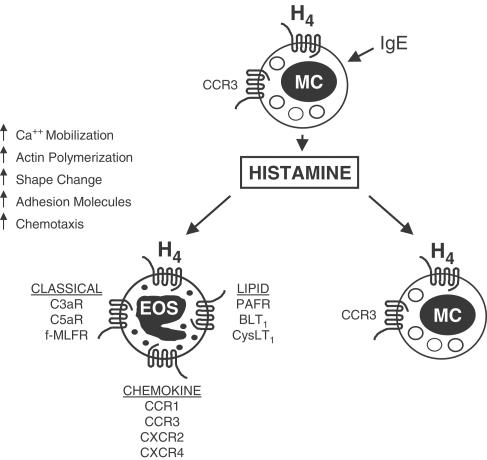Figure 1.
Mechanism of histamine-induced recruitment of eosinophils and mast cells in chronic allergic inflammation. Histamine H4 GPCRs are expressed on the surface of both eosinophils and mast cells. Antigen-IgE complex-dependent crosslinking of FcɛRI on the surface of resident mast cells stimulates the secretion of histamine, which binds to and activates the H4 receptor on eosinophils. Signalling through the H4 receptor triggers a series of signal transduction events (calcium mobilization, actin polymerization, shape change, upregulation of adhesion molecule expression) leading to directional migration (chemotaxis) and accumulation of eosinophils into sites of inflammation. Upon release, histamine can also stimulate the recruitment of additional mast cells into the inflammatory site, by activation of the mast cell expressed H4 receptor. As shown in the figure, the H4 receptor is one of a number of G-protein coupled chemottractant receptors expressed on eosinophils. These include members of the chemokine receptor family, receptors for classical chemoattractants (complement cleavage fragments, formyl peptides and lipid mediators). Abbreviations: EOS, eosinophil; MC, mast cell; IgE, immunoglobulin E; H4, histamine receptor type 4; PAFR, platelet activating factor receptor; BLT1, leukotriene B4 receptor type 1; CysLT1, leukotriene D4 receptor type 1; CCR1, C-C chemokine receptor type 1; CCR3, C-C chemokine receptor type 3; CXCR2, C-X-C chemokine receptor type 2; CXCR4, C-X-C chemokine receptor type 4; C3aR, complement 3a receptor; C5aR, complement 5a receptor; f-MLFR, N-formyl-methionyl-leucyl-phenylalanine receptor.

